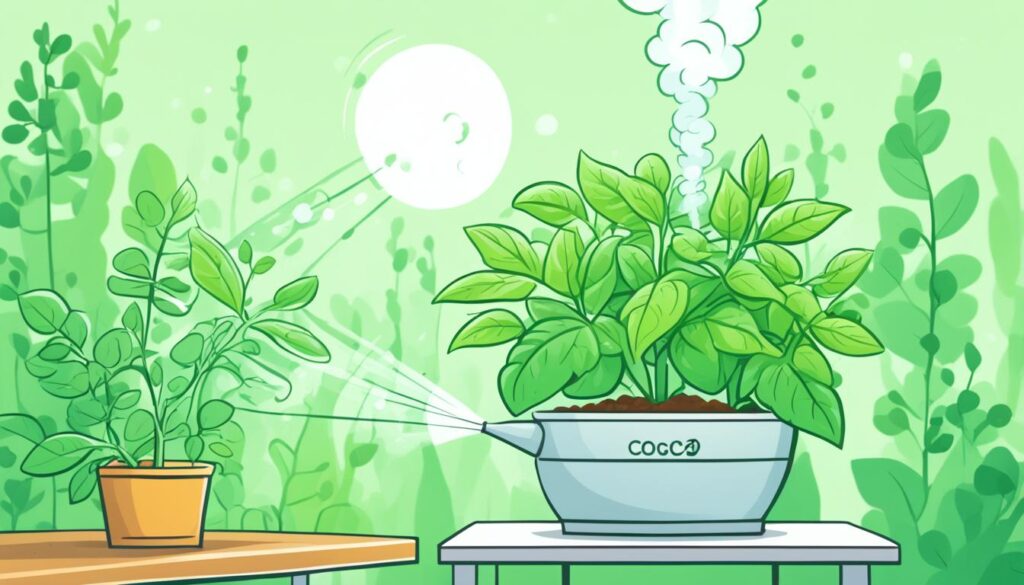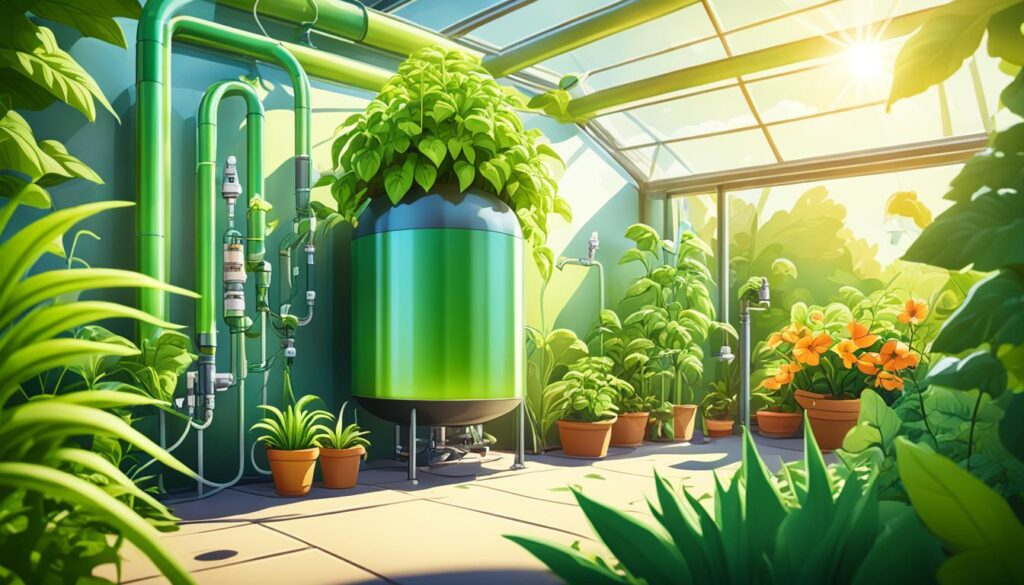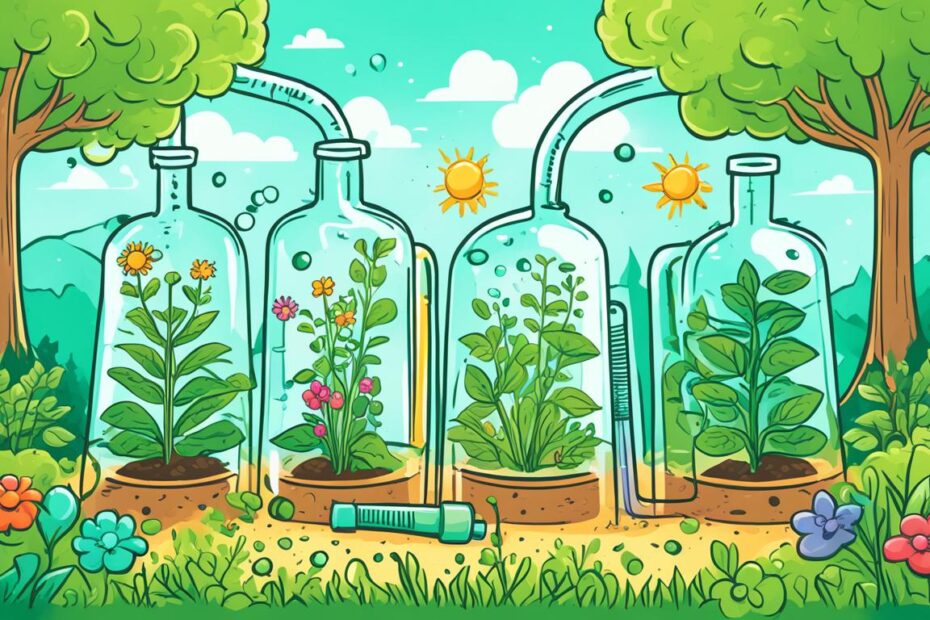Have you ever wondered how to give your plants a growth boost? We all know that plants depend on carbon dioxide (CO2) for photosynthesis, but did you know that the atmospheric concentration of CO2 is often insufficient for optimal plant growth? That’s right! To maximize your plant’s growth potential, you may need to supplement it with additional CO2.
In this section, we will dive into the importance of CO2 for plants and explore how to increase CO2 levels in a cost-effective manner. Get ready to uncover the secrets of plant growth and discover how you can make CO2 for your plants.
Key Takeaways:
- Carbon dioxide (CO2) is essential for plant growth and the process of photosynthesis.
- The atmospheric concentration of CO2 is often insufficient for optimal plant growth.
- Supplemental CO2 can enhance photosynthesis and boost plant growth.
- We will discuss various methods of CO2 supplementation and their advantages and disadvantages.
- Factors like timing, duration, and concentration of CO2 supplementation are crucial for its effectiveness.
The Role of CO2 in Plant Growth
Photosynthesis is the vital process by which plants convert carbon dioxide (CO2) and water into sugars, providing essential energy for growth. During this remarkable process, oxygen is released as a byproduct, contributing to the Earth’s atmospheric composition.
However, the natural atmospheric concentration of CO2 is often insufficient to meet the optimal demands of plants for vigorous growth. Adequate CO2 levels are crucial for the rate of photosynthesis and overall plant development.
Different types of plants have varying responses to CO2 levels, but increasing the ambient CO2 concentration has proven to be highly beneficial. This supplementation can significantly boost yields, maximize plant growth, and ensure efficient resource utilization.
“CO2 is like plant food—it has a vital role in facilitating photosynthesis and fueling the growth and development of plants. Increasing carbon dioxide levels can create a thriving green environment.”
While it is essential to provide plants with enough CO2 to stimulate growth, excessive levels can be detrimental. Balancing the concentration of CO2 is crucial to avoid potential negative effects.
Impact on Photosynthesis and Plant Growth
The concentration of CO2 significantly influences the rate of photosynthesis. With higher CO2 levels, plants can more efficiently produce sugars, leading to increased biomass and better overall plant growth.
Elevated CO2 concentrations can accelerate the growth of different plant organs, such as leaves, stems, roots, and fruits. This enhanced growth potential can result in higher yields and improved crop productivity.
Notably, the benefits of increased CO2 concentration on plant growth are most pronounced under conditions where other essential resources such as light, water, and nutrients are not limiting factors. Therefore, optimizing the availability of all these resources is crucial for maximizing the impact of enhanced CO2 levels.
Comparison of CO2 Concentration Effects on Plant Growth
| CO2 Concentration | Effect on Plant Growth |
|---|---|
| Below Optimal (300-400 ppm) | Limited photosynthesis and slower growth |
| Optimal (1,200-1,500 ppm) | Maximized photosynthesis and accelerated growth |
| Excessive (>2,000 ppm) | Potential negative impacts on plant health |
Optimizing CO2 concentration is a key factor in creating an environment that fosters optimal plant growth and maximizes yield. By providing plants with adequate CO2 levels, you can unlock their full potential and create a thriving green space.
CLICK HERE TO CHECK OUR RECOMMENDED PRODUCTSMethods of CO2 Supplementation
CO2 supplementation plays a crucial role in enhancing photosynthesis and promoting plant growth. There are several methods available for introducing additional CO2 into the growing environment. Each method has its own advantages and disadvantages, offering growers various options to choose from.
CO2 Generators: Utilizing CO2 generators is a popular method of supplementation. These devices burn natural gas, propane, or alcohol to produce CO2 as a byproduct. The generated CO2 is then released into the grow space, providing plants with the necessary carbon dioxide for photosynthesis. This method offers the advantage of increased growth rates and earlier maturity. However, it requires proper ventilation to avoid the build-up of pollutants and may entail higher energy costs.
Fermentation: Fermentation is another method used to supplement CO2. Ethanol fermentation produces CO2 as a result of yeast breaking down sugars. This method is cost-effective and relatively easy to implement, making it suitable for small-scale growers. However, it may require additional equipment for controlling the fermentation process, and the CO2 release may not be consistent.
Dry Ice: Dry ice, which is solid carbon dioxide, can also be used for CO2 supplementation. As the dry ice sublimates, it releases CO2 into the grow space. This method is straightforward and does not require complex equipment. However, it can be challenging to control the release rate of CO2, and excessive use may lead to reduced water use efficiency in plants.
Natural Decomposition Processes: Natural decomposition processes, such as composting and mulching, can contribute to CO2 supplementation. Organic materials, such as food waste or plant residues, undergo decomposition, releasing CO2 into the surrounding environment. This method is environmentally friendly and cost-effective. However, it requires time for decomposition to occur, and the CO2 release may not be consistent or easily controlled.
To further illustrate the advantages and disadvantages of the different CO2 supplementation methods, refer to the table below:
| CO2 Supplementation Method | Advantages | Disadvantages |
|---|---|---|
| CO2 Generators | Increased growth rates, earlier maturity | Requires proper ventilation, higher energy costs |
| Fermentation | Cost-effective, easy to implement | May require additional equipment, inconsistent CO2 release |
| Dry Ice | Straightforward, no complex equipment required | Challenging to control CO2 release, reduced water use efficiency |
| Natural Decomposition Processes | Environmentally friendly, cost-effective | Time required for decomposition, inconsistent CO2 release |

It’s important for growers to carefully consider the advantages and disadvantages of each CO2 supplementation method before implementing it in their growing environment. Factors such as cost, control, and overall efficiency should be taken into account to ensure successful CO2 supplementation. Remember, the goal is to maximize plant growth and optimize yield while minimizing potential risks and costs.
Factors Influencing CO2 Application
The timing, duration, and concentration of CO2 supplementation play a crucial role in its effectiveness. To optimize CO2 application, it is essential to consider various growing factors that can impact the response of plants to CO2 supplementation.
Timing: CO2 supplementation is most beneficial during the flowering stage of plant growth. At this stage, plants have a higher demand for CO2 to support their reproductive processes and achieve maximum yield. Providing CO2 during this critical period can enhance flower development and overall plant performance.
Duration: The duration of CO2 supplementation should align with the photosynthetically active period of plants. This period varies depending on the plant species and environmental conditions. It is important to monitor and adjust the duration of CO2 supplementation to ensure optimal CO2 levels are maintained throughout the photosynthetically active phase.
Concentration: The concentration of CO2 is a key factor in its effectiveness. While higher CO2 levels can stimulate faster growth and increased photosynthesis, excessive CO2 can be detrimental to plant health and lead to issues such as leaf damage or nutrient deficiencies. Maintaining the appropriate CO2 concentration range is crucial for achieving desired results.
Furthermore, different growing factors can also influence the response of plants to CO2 supplementation. These factors include:
- Light Intensity: Higher CO2 levels can enhance light utilization, especially in low-light conditions. This allows plants to maximize photosynthesis and promote faster growth.
- Temperature: Elevated CO2 concentrations can increase the optimal temperature requirement for plants. This enables growth even in higher temperature conditions, enhancing plant resilience and productivity.
- Water Availability: CO2 supplementation can reduce stomatal conductance and transpiration, resulting in improved water use efficiency. This is particularly beneficial in arid and water-limited environments.
- Nutrient Levels: Increased CO2 levels can enhance nutrient uptake in plants, leading to faster root and shoot growth. This can improve overall plant vigor and yield.
By maintaining the right balance of these factors and optimizing CO2 application, growers can maximize the benefits of CO2 supplementation and promote healthy and productive plant growth.
“The concentration, timing, and duration of CO2 supplementation, along with consideration of other growing factors, are essential for achieving optimal results.”
| Growing Factor | Effect of CO2 Supplementation |
|---|---|
| Light Intensity | Enhanced light utilization and faster photosynthesis |
| Temperature | Increased optimal temperature range for growth |
| Water Availability | Improved water use efficiency and reduced transpiration |
| Nutrient Levels | Enhanced nutrient uptake and faster root and shoot growth |
The Impact of CO2 on Different Growing Factors
CO2 supplementation can have a profound effect on various growing factors, leading to improved plant growth and productivity. Let’s explore the ways in which CO2 influences essential elements such as light, water, temperature, and nutrient uptake.
CO2 and Light
Increased levels of CO2 can enhance light utilization, especially in low-light conditions. This is particularly advantageous for indoor gardens or areas with limited natural sunlight. By optimizing CO2 concentrations, plants are able to maximize the photosynthesis process, resulting in faster growth and higher yields.
CO2 and Water
Elevated CO2 levels play a crucial role in improving water use efficiency. When plants are exposed to higher levels of CO2, their stomatal conductance reduces, resulting in reduced transpiration. As a result, plants are able to conserve water and allocate more resources towards growth and development.
CO2 and Temperature
Higher concentrations of CO2 can impact the optimal temperature requirement for plants. This means that even in higher temperature conditions, plants can still flourish and achieve optimal growth. By adapting to varying temperature environments, plants are better equipped to thrive in challenging climates.
CO2 and Nutrient Uptake
CO2 supplementation can enhance the uptake of essential nutrients by the roots of plants. Increased CO2 levels stimulate root growth, allowing plants to absorb nutrients more efficiently. This leads to faster root and shoot development, resulting in healthier and more robust plants.
Overall, CO2 supplementation has a positive impact on various growing factors, ranging from optimizing light utilization and water efficiency to adapting to temperature variations and enhancing nutrient uptake. By harnessing the power of CO2, growers can unlock the full potential of their plants and achieve exceptional growth and yield.

Optimizing CO2 Levels in the Grow Space
When it comes to maximizing plant growth, optimizing CO2 levels is crucial. The ideal CO2 level depends on factors such as light intensity and the size of your grow space. Research suggests that CO2 levels between 1,200 ppm and 1,500 ppm are most effective in promoting healthy plant growth and maximizing yields.
However, maintaining the right CO2 concentration requires careful monitoring. By regularly monitoring CO2 levels, you can ensure that your plants receive the optimal amount of CO2 they need for robust growth. Investing in CO2 monitoring equipment, such as CO2 monitors, controllers, and sensors, can help you maintain precise control over CO2 levels and make necessary adjustments to your CO2 supplementation.
Various CO2 systems are available for effective CO2 supplementation in your grow space. Consider the following options:
- Slow-release bags: These convenient and cost-effective bags slowly emit CO2 into the grow space over an extended period. They are easy to install and require minimal maintenance.
- CO2 generators: These systems produce CO2 from natural gas or propane. They provide a continuous supply of CO2 and are suitable for larger grow spaces.
- Compressed tanks: These tanks contain compressed CO2 gas. They offer precise control over CO2 levels and are ideal for both small and large grow spaces.
Choosing the right CO2 system depends on the size of your grow space, budget, and personal preference. Consider consulting with experts or experienced growers to determine the most suitable CO2 supplementation method for your specific needs.
Optimizing CO2 Levels with Precision
Before implementing CO2 supplementation, it is essential to ensure proper CO2 distribution in your grow space. Strategically placing fans and vents can help circulate CO2 and maintain consistent levels throughout your grow area.
Here is an example of a CO2 distribution strategy using fans and vents:
| Location | Fan Direction | Vent Position |
|---|---|---|
| A | Blowing towards plants | Open |
| B | Blowing towards plants | Closed |
| C | Blowing away from plants | Open |
By strategically placing fans and vents as shown in the table above, you can ensure efficient CO2 distribution and achieve uniform CO2 levels throughout your grow space. This method helps prevent stagnant pockets of CO2 and promotes optimal plant growth.
Remember, maintaining the right CO2 levels is essential for maximizing plant growth and yield. By optimizing CO2 levels in your grow space and utilizing the appropriate CO2 monitoring and supplementation systems, you can provide your plants with the ideal conditions for healthy and productive growth.
Conclusion
CO2 supplementation is a powerful technique for optimizing plant growth and maximizing yield. By increasing CO2 levels in your grow space, you can significantly enhance photosynthesis, accelerate growth, and improve overall crop productivity.
When implementing CO2 supplementation, it is crucial to consider factors such as timing, duration, and concentration of CO2 application. The flowering stage of plant growth is the ideal time for CO2 supplementation, and maintaining the right balance of CO2 concentration during the photosynthetically active period is essential for optimal results.
Additionally, it is important to understand the impact of CO2 on different growing factors. Elevated CO2 levels can improve light utilization, water use efficiency, temperature tolerance, and nutrient uptake, leading to healthier and more productive plants.
Monitoring and optimizing CO2 levels in your grow space is vital for success. Utilize CO2 monitors, controllers, and sensors to maintain the desired concentration, and choose the appropriate CO2 supplementation method for your specific needs. With careful CO2 optimization, you can unlock the full potential of your plants and enjoy bountiful yields.
FAQ
Why is CO2 important for plant growth?
CO2 is essential for photosynthesis, the process by which plants convert CO2 and water into sugars, releasing oxygen as a byproduct. However, atmospheric CO2 levels are often insufficient for optimal plant growth.
How can I increase CO2 levels for my plants?
CO2 levels can be increased through supplementation. There are various methods, including using CO2 generators, fermentation, dry ice, and natural decomposition processes.
What are the advantages and disadvantages of CO2 supplementation?
CO2 supplementation has advantages such as increased growth rates and improved water use efficiency. However, it can also incur additional costs, require modifications to the growing environment, and pose potential risks if not properly managed.
What factors should I consider when applying CO2?
Factors such as timing, duration, and concentration of CO2 supplementation, as well as the impact on different growing factors like light intensity, temperature, water availability, and nutrient levels, should be taken into account.
How does CO2 impact different growing factors?
CO2 supplementation can improve light utilization, reduce water use, increase the optimal temperature requirement for plants, and enhance nutrient uptake for faster root and shoot growth.
What is the optimal CO2 level for maximizing growth?
CO2 levels between 1,200 ppm and 1,500 ppm have been found to be most effective in promoting plant growth. Monitoring CO2 levels is crucial for maintaining the right concentration.
How can I monitor and optimize CO2 levels in my grow space?
Growers can use CO2 monitors, controllers, and sensors to ensure precise control and adjust CO2 supplementation as needed. Different CO2 systems, including slow-release bags, generators, and compressed tanks, are available for CO2 supplementation.
What are the benefits of optimizing CO2 levels in the grow space?
Optimizing CO2 levels can enhance photosynthesis, accelerate growth, and improve overall crop productivity, leading to healthier and more productive plants.
